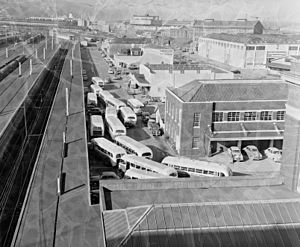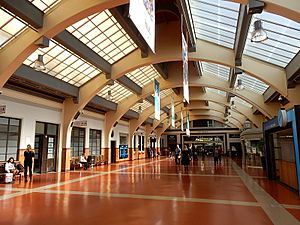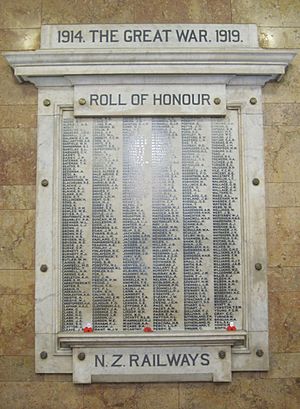Wellington railway station facts for kids
Quick facts for kids
Wellington
|
|||||||||||||||||||||||||||||||||||||||||
|---|---|---|---|---|---|---|---|---|---|---|---|---|---|---|---|---|---|---|---|---|---|---|---|---|---|---|---|---|---|---|---|---|---|---|---|---|---|---|---|---|---|
| Metlink regional rail | |||||||||||||||||||||||||||||||||||||||||

Wellington railway station frontage at night, 14 May 2003.
|
|||||||||||||||||||||||||||||||||||||||||
| Location | Bunny Street, Pipitea, Wellington, New Zealand | ||||||||||||||||||||||||||||||||||||||||
| Coordinates | 41°16′43″S 174°46′51″E / 41.27861°S 174.78083°E | ||||||||||||||||||||||||||||||||||||||||
| Owned by | New Zealand Railways Corporation | ||||||||||||||||||||||||||||||||||||||||
| Line(s) | North Island Main Trunk Wairarapa Line Johnsonville Line |
||||||||||||||||||||||||||||||||||||||||
| Platforms | 9 | ||||||||||||||||||||||||||||||||||||||||
| Connections | Services | ||||||||||||||||||||||||||||||||||||||||
| Construction | |||||||||||||||||||||||||||||||||||||||||
| Structure type | At-grade terminal station | ||||||||||||||||||||||||||||||||||||||||
| Parking | Yes | ||||||||||||||||||||||||||||||||||||||||
| Disabled access | most Metlink services (operated by Transdev Wellington) | ||||||||||||||||||||||||||||||||||||||||
| Other information | |||||||||||||||||||||||||||||||||||||||||
| Station code | WELL (Metlink) WLG (KiwiRail Network) |
||||||||||||||||||||||||||||||||||||||||
| Fare zone | 1 | ||||||||||||||||||||||||||||||||||||||||
| History | |||||||||||||||||||||||||||||||||||||||||
| Opened | 19 June 1937 | ||||||||||||||||||||||||||||||||||||||||
| Electrified | 1938 | ||||||||||||||||||||||||||||||||||||||||
| Services | |||||||||||||||||||||||||||||||||||||||||
|
|||||||||||||||||||||||||||||||||||||||||
| Designated: | 25 September 1986 | ||||||||||||||||||||||||||||||||||||||||
| Reference #: | 1452 | ||||||||||||||||||||||||||||||||||||||||
Wellington railway station is the main train station in Wellington, New Zealand. It's the last stop for trains on the North Island Main Trunk, Wairarapa Line, and Johnsonville Line.
The station first opened in June 1937. It took the place of two older stations in Wellington, called Lambton and Thorndon.
Contents
History of Wellington Station
How the Station Was Designed
The station was built on land that was once part of Wellington Harbour. To make sure the ground was strong enough, engineers tested the soil in 1928. They decided to use special concrete piles to support the building. This station was one of the first big buildings in New Zealand designed to stand strong during earthquakes.
The architect, Gray Young, planned a large U-shaped building. It was 105.5 metres (346 feet) long and 23.5 metres (77 feet) high. Many strong concrete piles were driven into the ground to support it. On top of these piles, a steel frame was built. This frame was covered with reinforced concrete and 1.75 million bricks. The bricks on the outside had special slots for steel rods, which made the walls even stronger. Inside, beautiful granite and marble were used for decoration.
The main entrance has eight tall columns. They lead into a big hall where you can buy tickets. This hall has a high, arched ceiling. The station also had waiting rooms, toilets, a large dining room, a barber shop, and shops selling books and fruit. There was even a nursery on the top floor where parents could leave their children while they waited for their train or went shopping.
When it was finished, Wellington station was the biggest building in New Zealand. It covered a huge area and had lots of space inside. It was designed to hold 675 staff members from the Railways Department. Before this, these staff worked in 11 different buildings around the city.
The train platforms were made of concrete and covered by roofs. They were long enough for up to 12 train carriages. Platform 9 was special because it was built as a road, not a railway track. This was for buses run by New Zealand Railways Road Services. Outside the station, a park was created with lawns and paths.
Building the Station
The company Fletcher Building won the contract to build the station in 1933. It was the biggest single building contract in New Zealand at that time. Joe Craig, who was only 26, was chosen to manage the project. He had experience from other big building jobs.
Work started in January 1934. At first, only 12 people worked on it, but by 1936, there were 161 workers. The building process went very smoothly. The foundation stone was laid on December 17, 1934, by the Duke of Gloucester. About 5,000 people came to watch this important event.
Later, more parts were added to the station complex. An electric substation was built in 1936. A workshop for maintaining locomotives was also built in 1936 and is still used today. In 1938, more office space was added to the Featherston Street Wing to fit all the staff. A two-story building with a social hall and a garage was also built in 1937.
Wellington Railway Yard
The Wellington railway yard is where trains are stored and serviced. It includes tracks for sorting trains and a special depot for electric trains. There's also a rail line that goes under a stadium walkway to the port, where freight containers are handled.
The main signal box for Wellington, called the "A Box," is near the stadium walkway. From here, workers can see all the station platforms and main lines. There are plans to add more tracks and upgrade the signal system to make train movements smoother and faster.
In 2019, a derailed freight wagon caused big problems for two days. It damaged both tracks leading out of Wellington, stopping many commuter trains. Because of this, the closed Kaiwharawhara railway station might be used as an emergency station in the future.
How the Station Has Been Used
The station officially opened on June 19, 1937. The old Lambton and Thorndon stations closed around the same time.
In the 1980s, the way the railway was run changed. Fewer staff were needed, so large parts of the station building became empty. Some areas were changed to fit new businesses. For example, the barber's shop and men's toilets became a cafe, and the women's waiting rooms became new toilets. The original dining hall was turned into office space.
When the WestpacTrust Stadium was built nearby in 1999, a walkway was added. This walkway goes from Thorndon Quay to the stadium, with ramps leading from the train platforms. To make space for this, some of the platform roofs were shortened.
Over the years, the ownership and management of the railway changed several times. In 2003, the station building was renovated. This big project cost NZ$14.6 million. Part of Victoria University moved into the West wing, and KiwiRail (the company that now owns the railways) moved into the East wing. This work also made the building stronger against earthquakes.
In 2006, a New World supermarket opened on the ground floor. In 2010, the old social hall was turned into office space. The station is considered a very important historic place and was officially registered as a Category I Historic Place in 1986.
In 2018, there was talk of selling the building, but the government stopped the sale. The building needs more earthquake strengthening, which will cost a lot of money.
World War I Memorial
Inside the station's office entrance, there is a special memorial. It lists 450 members of the New Zealand Railways Department who died in World War I. Many thousands of railway workers served in the war.
This memorial was first shown in 1922 at the old Railways Department head office. When the new station opened in 1937, the memorial was moved to its current spot.
Filming Location
Wellington railway station has been used in movies and TV shows:
- In the 1981 film Goodbye Pork Pie, a car drives through the station concourse.
- In 2009, a TV ad for a train ticketing company in the United Kingdom showed a large group of sheep using the station.
- In 2014, celebrity chef Nigella Lawson filmed a commercial for Whittaker's chocolate in the station's main hall.
Services
Two main companies run train services from Wellington.
Train Services
Transdev runs the local train network for the Greater Wellington Regional Council. These trains serve Wellington and nearby areas. They also run the Wairarapa Connection service to Masterton. During busy times, 8–10 trains leave Wellington every hour:
- 2 trains per hour on the Johnsonville Line to Johnsonville.
- 3 trains per hour on the Kapiti Line to Waikanae (2 per hour on weekends).
- 3 trains per hour on the Hutt Valley Line to Upper Hutt (2 per hour on weekends).
- 1 train per hour on the Melling Line to Melling (weekdays only).
- 5 Wairarapa Connection services per day to Masterton (2 per day on weekends).
The Great Journeys of New Zealand (KiwiRail) runs two long-distance train services from Wellington:
- The Capital Connection goes to Palmerston North once a day on weekdays.
- The Northern Explorer goes to Auckland Strand three times a week.
Bus Services
Buses use the road next to platform 9 at the station:
- Interislander shuttles take people to the ferry terminal.
- InterCity and Newmans long-distance buses also stop here.
Bus Terminal
The main bus terminal, once called Lambton Interchange, is connected to the station by an underground walkway. Most Wellington bus routes use this terminal.






